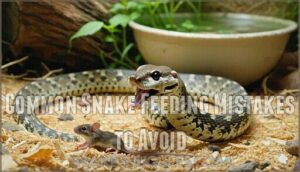This site is supported by our readers. We may earn a commission, at no cost to you, if you purchase through links.

Hatchlings and juveniles need smaller meals more often, usually twice a week, as they’re growing rapidly. Adult snakes, with slower metabolisms, thrive on a meal every 1-2 weeks.
Always verify the prey’s size matches your snake’s widest part—think of it like fitting the right puzzle piece. Stick to frozen-thawed prey for safety, unless your snake’s picky.
Overfeeding can lead to obesity, so keep an eye on feeding cues like active hunting behaviors. Remember, a well-fed snake is a healthy snake—just don’t let them convince you otherwise!
Table Of Contents
- Key Takeaways
- Choosing The Right Snake Food
- Factors Affecting Snake Feeding Frequency
- Preparing Food for Your Pet Snake
- Feeding Frequency for Different Snake Species
- Snake Feeding Habits and Behaviors
- The Dangers of Overfeeding Your Snake
- Supplements and Vitamins for Your Pet Snake
- Providing Fresh Water for Your Snake
- Monitoring and Adjusting Your Snake’s Feeding Schedule
- Common Snake Feeding Mistakes to Avoid
- Frequently Asked Questions (FAQs)
- What is the best feeding schedule for ball pythons?
- How soon after a snake eats does it poop?
- How often should I Feed my snake?
- How do you feed a snake a healthy diet?
- How do snakes adjust their diet?
- Why is feeding frequency important in snake care?
- How often should I feed snakes?
- Should I feed my snake at night or day?
- Can I feed my snake every 5 days?
- How long can snakes go between feedings?
- Conclusion
Key Takeaways
- Feed young snakes every 5-7 days, juveniles weekly, and adults every 10-14 days to match their metabolism and growth rate.
- Always use frozen-thawed prey that’s slightly wider than your snake’s widest part to ensure safety and proper digestion.
- Watch for hunger cues like active prowling and tongue flicking, and avoid overfeeding to prevent obesity and health issues.
- Keep fresh water available, monitor humidity, and maintain a consistent feeding schedule tailored to your snake’s species, age, and size.
Choosing The Right Snake Food
Choosing the right food for your snake isn’t complicated, but it does require some attention to detail.
From picking prey that matches your snake’s size to deciding between live or frozen, your choices can directly impact their health and happiness.
Importance of Prey Size
Choosing the right prey size is like finding the perfect puzzle piece for your snake’s diet.
A meal slightly wider than your snake’s girth helps facilitate smooth digestion and helps prevent digestive issues or regurgitation risks.
Stick to clear size guidelines: prey shouldn’t exceed the width of your snake’s body to avoid choking hazards.
Think of their feeding experience as balancing a scale—not too big, not too small.
Understanding appropriate prey options is vital for snake owners.
The proper snake feeding schedule starts with matching prey size to your snake’s needs for a healthy snake diet!
Prey Types for Different Snake Species
Understanding your snake’s diet means picking prey types that match their size, species, and natural habits.
Rodent varieties like mice and rats are a staple for many snakes, while insect options suit smaller species.
Bird prey, like quail, works for larger snakes, and some prefer amphibian diets or fish feeders.
Prey size matters too—stick to slightly bigger than your snake’s width, to keep their feeding schedule smooth and guarantees they stay healthy and happy.
Feeding Live Vs. Frozen Prey
Deciding between live prey and frozen prey can feel like a showdown of instinct versus convenience.
Live prey sparks instinct, while frozen prey offers safety and ease—choose what keeps both you and your snake at peace.
Here’s the breakdown:
- Safety: Live prey risks injury to your snake, while frozen thawed mice eliminate that danger.
- Ethics: Many consider frozen prey more humane, avoiding unnecessary harm to feeder animals.
- Ease: Handling difficulties with live prey, like storing and monitoring, push many to frozen prey’s simpler routine.
While live feeding snakes taps their hunting instincts, frozen prey reduces stress for both owner and reptile.
Test both prey types to find what works best for your pet.
Prey Quality and Freshness
Frozen prey keeps your snake healthy when stored correctly.
Use airtight containers to lock in prey quality and avoid spoilage signs like discoloration or bad smells.
Always thaw frozen prey properly—lukewarm water works best.
Avoid expired or poorly sourced prey types, as they harm your snake’s nutritional content.
Ethical sourcing guarantees safe meals, while improper storage duration invites unwanted risk, emphasizing the importance of proper handling.
Factors Affecting Snake Feeding Frequency
Feeding your snake isn’t a one-size-fits-all task—it depends on factors like age, size, activity, and environment.
Understanding these details guarantees your pet stays healthy and satisfied without overfeeding or going hungry, which is crucial for maintaining a healthy environment.
Snake Age and Feeding Frequency
Young snakes have big appetites, and their growth stages demand careful feeding frequency.
Hatchling frequency is typically every 5–7 days. Juvenile needs climb to twice weekly until they mature. Adult intervals are less frequent, around every 10–14 days.
Each snake is different, so monitor closely!
- Hatchlings: Feed every 5–7 days.
- Juveniles: Twice weekly supports rapid growth.
- Adults: Once every 10–14 days fits their slower metabolism.
- Adjust: Watch appetite shifts and modify the snake feeding schedule.
Snake Size and Feeding Frequency
Snake size plays a big role in feeding frequency.
Hatchlings often need meals twice a week to fuel rapid growth.
Juveniles can scale back to once a week.
Larger adult snakes, with slower metabolisms, typically thrive on a feeding schedule every 10-14 days.
Match prey size to the snake’s girth to prevent choking or digestive issues.
Keeping an eye on their weight and body condition confirms your feeding schedule supports their health and avoids over- or underfeeding.
Snake Activity Level and Feeding Frequency
Your snake’s activity level shapes its feeding frequency. A busy, prowling snake burns more energy, demanding extra food to fuel its metabolism.
Here’s how to adjust:
- Observe enclosure prowling or increased movement.
- Adjust feeding frequency during seasonal activity spikes.
- Note appetite shifts during shedding.
- Feed nocturnal snakes in the evening.
- Maintain a balanced snake feeding schedule to match digestion needs.
Environmental Factors and Feeding Frequency
Think of your snake’s enclosure as their personalized weather system.
Temperature gradients, humidity levels, and lighting cycles keep their feeding habits steady.
Seasonal changes can nudge you to tweak the snake feeding schedule.
A poor snake environment might dull their appetite, while an ideal setup guarantees they’re comfortable and ready to eat.
Monitor these environmental factors for a healthy feeding frequency!
This approach will help ensure your snake is always in the best condition to thrive, with their environment supporting their overall health and comfort.
Preparing Food for Your Pet Snake
Preparing your snake’s meals mightn’t sound glamorous, but it’s essential for their health.
From thawing frozen mice to choosing the right size prey, a little preparation goes a long way.
Thawing Frozen Prey
Thawing frozen prey properly guarantees your snake’s safety and nutrition.
Use this simple guide:
- Place frozen prey in a sealed bag.
- Submerge the bag in warm water (not hot).
- Monitor water temperature to avoid overheating.
- Wait patiently for full thawing—rushing risks prey quality.
- Verify the prey feels room temperature before feeding.
Slow, steady thawing keeps your snake healthy and happy.
For ideal thawing, consider using specialized reptile bags. This ensures proper care and maintains the prey’s quality, supporting your snake’s overall wellness.
Feeding Prey Whole
Feeding your snake whole prey isn’t just natural—it’s a powerhouse for health.
Whole prey guarantees nutritional completeness, supports digestion efficiency, and encourages natural behaviors, like swallowing and bone consumption, vital for balanced health.
Choose prey that matches your snake’s size and age for the best results.
| Benefit | Explanation | Key Tip |
|---|---|---|
| Nutritional Completeness | Provides all essential nutrients | Opt for frozen-thawed prey |
| Digestion Efficiency | Aids in smooth digestion | Avoid prey larger than body width |
| Natural Behaviors | Mimics wild feeding habits | Match prey variety to snake size |
Stick to your snake feeding schedule adjustments, balancing size, frequency, and prey type.
Prey Presentation and Feeding Techniques
Make mealtime engaging for your snake by experimenting with these simple feeding techniques:
- Use tongs to wiggle frozen-thawed prey, simulating live movement.
- Try in-enclosure feeding, placing prey in areas they naturally explore.
- For nocturnal feeding, offer prey during their active hours.
Always prioritize safety—watch for live feeding risks and make certain the feeding environment mimics their natural instincts.
Gut Loading Prey
When you prioritize gut loading, you’re giving your snake an edge in health and growth.
By feeding prey animals nutrient-rich diets for 24-72 hours, you enhance their nutritional content for your snake.
Opt for whole prey, like insects or rodents, and provide optimal supplements like calcium-rich foods.
This enhanced nutrition improves digestion, prey quality, and overall snake nutrition.
It’s a simple step with big benefits—kind of like meal-prepping for your snake!
Feeding Frequency for Different Snake Species
Knowing how often to feed your snake depends on its species, age, and size.
Whether you’re caring for a tiny corn snake or a massive python, getting the schedule right keeps your slithery friend healthy and happy.
Feeding Frequency for Young Snakes
Young snakes are little eating machines! Their fast metabolisms demand food every 5-7 days to support juvenile growth.
Aim for prey that’s slightly smaller or equal to their girth—this helps avoid digestion issues. Hatchling frequency is key; skipping meals can stunt growth or cause health problems.
Use frozen-thawed rodents for safety and match the meal size to their snake age and species. If you’re raising insect-eating snakes, don’t forget supplement needs like calcium.
Pay attention to feeding frequency and your snake’s cues—healthy, well-fed young snakes grow into vibrant adults, ready to slither into their next meal!
Feeding Frequency for Adult Snakes
Adult snakes need a balanced feeding schedule to match their slower metabolic rate.
Frequency depends on size, activity levels, and shedding impact.
Follow these guidelines:
- Weigh regularly: Larger adult snakes eat every 10–14 days.
- Prey size matters: Offer prey about 10% of their weight.
- Observe behavior: Hunger includes prowling or tongue flicking.
Keep it consistent for health!
Feeding Frequency for Pregnant or Breeding Snakes
When your snake’s in breeding season, its nutrition game changes.
Feed pregnant snakes every 5-7 days with prey that matches their widest girth. Focus on Calcium and balanced prey to support gestation feeding or egg production.
After laying, a nutrient-rich post-laying diet helps recovery. A steady feeding routine guarantees health through breeding recovery.
| Snake Stage | Recommended Frequency | Prey Size Match | Nutritional Focus | Timing Tips |
|---|---|---|---|---|
| Gestation Feeding | Every 5-7 days | Snake widest girth | Calcium-rich prey | Stick to evenings |
| Egg Production | Every 6 days | 1 prey item | Protein boost | Limit handling |
| Post-Laying Phase | Every 7-10 days | Smaller prey | Energy restoration | Feed gradually |
| Breeding Recovery | Every 5-7 days | Standard prey size | Bone/skin support | Monitor appetite |
| Normal Routine | Every 7-10 days | Regular prey | Balanced nutrients | Observe snake cues |
Snake Feeding Habits and Behaviors
Your snake’s feeding habits can tell you a lot about its health and needs, so it’s important to pay attention.
From hunger cues to feeding schedules, understanding these behaviors helps you keep your scaly friend happy and well-fed.
Understanding Your Snake’s Feeding Behavior
Understanding snake feeding behavior is like decoding a riddle.
Watch for patterns to guarantee proper care. Snakes often show clear feeding signals.
Here are three ways to decode their habits:
- Hunger Cues – Rising activity or prowling suggests hunger.
- Shedding Refusal – Snakes often avoid food while shedding.
- Regurgitation Causes – Feeding too soon after a meal can trigger issues.
Recognizing Hunger and Fullness Cues
A snake’s appetite comes with clear signals.
Watch for increased activity levels, frequent tongue flicking, and prowling near the feeding spot—classic hunger cues.
Fullness shows through a drop in activity, minimal tongue flicking, or ignoring food.
Sudden aggression? Likely hunger, not attitude.
Regular weight monitoring guarantees balanced feeding behavior.
Keep an eye on these feeding signals to guide proper food intake adjustments and maintain your snake’s health.
Adjusting Feeding Based on Behavior
Sometimes, your snake’s actions speak louder than words—or hisses! Adjust feedings by spotting hunger signs like enclosure prowling, tongue flicks, or weight changes.
If shedding refusal or stress arises, tweak their routine.
- Switch Prey: Experiment with different sizes or thawing methods.
- Adjust Intervals: Try wider feeding intervals.
- Check Environment: Keep their space stress-free.
The Dangers of Overfeeding Your Snake
Overfeeding your snake might seem harmless, but it can lead to obesity and serious health issues.
Keeping meals on schedule guarantees your pet stays healthy and avoids turning into a scaly couch potato.
Risks of Obesity in Snakes
Obesity in snakes isn’t just a cosmetic issue—it’s a health hazard.
Excess weight stresses their organs, leading to problems like fatty liver or reproductive problems.
Imagine carrying a heavy backpack all day—it’s exhausting and limits movement.
Snake obesity also causes mobility issues and lowers their quality of life, often resulting in a reduced lifespan.
Avoid overfeeding by practicing careful snake weight management and monitoring portion sizes.
Signs and Symptoms of Overfeeding
Spotting overfeeding? Watch for obesity indicators that harm your snake’s health.
Overeating can lead to serious issues like organ damage or digestion problems.
Keep an eye out for these red flags:
- Lethargy symptoms: Is your snake lounging more than usual?
- Scale stretching: Notice scales looking unusually tight?
- Regurgitation signs: Food coming back up means trouble.
- Constipation: Digestive stalls signal overfeeding mistakes.
Proper feeding avoids these snake feeding challenges.
Prevention and Management of Overfeeding
Overfeeding can lead to obesity, regurgitation, and a less active snake.
To prevent snake feeding obesity, focus on Weight Monitoring. Regularly weigh your snake and compare it to an appropriate weight range for its species. Adjust portion sizes or frequency to avoid unnecessary weight gain.
Occasional meal skipping mimics nature and prevents overfeeding. Make certain your snake gets low-impact exercise, like climbing or exploring enriched enclosures.
If regurgitation signs appear or you’re unsure about dietary adjustments, seek a Vet Consultation.
| Step | Why It Matters | Pro Tip |
|---|---|---|
| Weight Monitoring | Detect obesity risks | Log weights monthly. |
| Dietary Adjustments | Prevent overfeeding | Use prey no wider than snake’s girth. |
| Vet Consultation | Professional guidance | Always consult for health issues. |
| Meal Skipping | Supports healthy habits | Skip meals once every few weeks. |
Supplements and Vitamins for Your Pet Snake
Your snake may not need a multivitamin, but some key supplements can help prevent health issues, especially for species with specific dietary needs.
Calcium and vitamin D3 are essential for strong bones, and they’re easy to add safely with proper guidance to ensure strong bones.
Importance of Calcium and Vitamin D3
If your snake’s bones could talk, they’d thank you for ensuring proper calcium intake and Vitamin D3 for calcium absorption and D3 synthesis.
These nutrients prevent metabolic bone disease and other deficiency symptoms.
Keep your snake’s diet balanced with supplements to maintain its health:
- Stronger bones and better mobility
- Prevention of skeletal issues
- Support for a healthy body structure
- Improved nutritional content
Types of Supplements for Snakes
Calcium supplements, Vitamin D3, and multivitamins are great additions to your snake’s diet when needed.
Snakes eating whole prey rarely require extras, but dietary gaps can sometimes occur.
Mineral blocks offer additional calcium, while multivitamins enhance nutritional content.
Consider snake calcium options for peak health.
Stick to the recommended supplement dosage for safety.
Think of these supplements as fine-tuning your snake’s health, ensuring they thrive without overcomplicating their natural dietary needs, which is key to their overall well-being.
Administering Supplements Safely and Effectively
Administering snake supplements doesn’t have to feel like rocket science! Follow these steps for safe and effective nutrition:
- Choose supplement types like calcium or vitamin D3 based on your snake’s nutritional needs.
- Calculate dosage carefully—don’t eyeball it; too much can harm.
- Use proper administration methods, like dusting prey or adding to water.
- Store supplements safely in a cool, dry place to preserve potency.
Providing Fresh Water for Your Snake
Keeping your snake hydrated is just as important as feeding it properly.
Make sure to provide clean, fresh water daily, because no one enjoys sipping from a dirty bowl—not even your scaly friend!
Water Quality and Freshness
Water’s a game-changer for your snake’s health.
Always check your water source—it should be clean and free of chemicals.
Regular bowl cleaning keeps bacteria away, while proper hydration levels support shedding and overall snake health.
Additives like water conditioners can boost water quality.
Here’s a quick guide:
| Tip | Action |
|---|---|
| Water source | Use filtered or distilled water. |
| Bowl cleaning | Clean weekly with reptile-safe soap. |
| Hydration levels | Refill to guarantee constant availability. |
| Water additives | Use conditioners for tap water. |
| Shedding hydration | Increase humidity if shedding. |
To ensure your snake stays healthy, remember that proper hydration is crucial, and regular maintenance of the water bowl is necessary.
This includes cleaning the bowl and using the right water additives to keep your snake in top condition.
Water Bowls and Hydration Systems
Keep hydration simple by picking a stable, easy-to-clean water bowl made from safe materials like ceramic or heavy-duty plastic.
Choose the right water bowl size to fit your snake’s environment without spilling. For convenience, automatic waterers or misting systems can guarantee water availability while helping with humidity control.
Fresh water daily maintains quality and supports hydration, keeping your snake happy in its feeding and living space, which is essential for overall health and requires easy-to-clean water bowls, and supports the idea that fresh water is crucial.
Monitoring and Maintaining Proper Humidity
Humidity plays a big role in snake health—too dry can cause shedding issues, while excess moisture invites mold and bacteria.
Stay on top of it with these tips:
Humidity Level Ideal Substrates Ventilation Misting Frequency
- Use a quality hydrometer for accuracy.
- Mist only as needed—no soggy messes.
- Prevent mold by cleaning damp spots.
Monitoring and Adjusting Your Snake’s Feeding Schedule
Adjusting your snake’s feeding schedule might feel like a guessing game, but keeping an eye on its behavior and weight makes it easy.
If your snake starts prowling more than usual or looks a bit rounder than it should, it’s time to tweak the plan.
Tracking Feeding Frequency and Amount
Tracking your snake’s meals is like being its personal health coach—it’s simple and worth it!
Regular monitoring helps keep your snake feeding schedule on point:
- Feeding log: Record dates, meal size, and prey type.
- Weight monitoring: Weigh the snake regularly to track growth rate.
- Spot trends: Look for signs of regurgitation or overfeeding.
- Adjustments: Fine-tune feeding frequency for balanced meals.
This process allows for a comprehensive approach to your snake’s dietary needs, ensuring a healthy and thriving pet.
Adjusting Feeding Schedules Based on Snake Age and Size
Feeding young snakes means frequent meals, while adults enjoy longer breaks.
Hatchling frequency is every 5-7 days since they grow fast. Juvenile schedules shift to weekly feedings as they gain size.
Adult intervals stretch to 10-14 days due to slower growth.
Match prey size to your snake’s girth, and use weight monitoring to fine-tune feeding schedules.
Monitoring Snake Health and Adjusting Feeding Accordingly
Adjusting your snake’s feeding schedule starts with weight monitoring and keeping an eye on body condition.
If you notice shedding delays or irregularities, these might impact appetite. Refusal reasons, like stress or illness, could signal bigger issues.
Check activity levels—lazy snakes might need less food, while active ones burn more calories. When things seem off, don’t hesitate to schedule a veterinary consult.
Observing snake feeding behavior changes guarantees their diet matches their health needs.
- Track weight regularly
- Watch shedding schedules
- Assess appetite shifts
- Review activity patterns
- Consult veterinarians for concerns
Common Snake Feeding Mistakes to Avoid
Feeding your snake might seem straightforward, but small mistakes can lead to big problems.
By avoiding common pitfalls like overfeeding or improper prey preparation, you’ll keep your pet healthy and thriving.
Inadequate Feeding Frequency
Is your snake looking sluggish or showing signs of stunted growth? An inadequate snake feeding frequency can lead to nutritional deficiencies, weakened immunity, organ damage, and even a reduced lifespan.
Sticking to proper snake feeding guidelines is key—feed younger snakes more often to support growth and space out adult meals appropriately.
A consistent snake diet prevents long-term health issues, and following proper snake feeding guidelines is crucial for a snake’s overall health, including supporting growth.
Poor Prey Quality and Presentation
Skipping meals isn’t the only feeding hiccup—spoiled prey or improper thawing can cause big problems.
Always check your frozen prey for quality before feeding.
Thawing frozen prey in warm water (not microwaves!) guarantees safety and avoids unnatural presentation, which might lead to refusals.
Prey handling matters—keep it clean, fresh, and close to room temperature.
Offering variety boosts nutrition and prevents deficiencies, so mix up mice, rats, or other options.
Gut loading prey works like giving your snake a supercharged snack.
The right prey quality and size keep your snake nibbling happily and digesting smoothly.
Overfeeding and Underfeeding
A poor snake feeding schedule can lead to overfeeding or underfeeding—both harmful.
Overfeeding causes obesity, organ damage, and digestion problems, while underfeeding leads to weight loss, growth stunting, and malnutrition.
Here’s how to dodge these snake feeding mistakes:
- Watch the scales: Regularly check your snake’s weight to spot health impacts early.
- Track meals: Stick to feeding guidelines based on species, age, and size.
- Read the signs: Hunger cues—like active prowling—help avoid unnecessary feeding.
Moderation keeps your snake healthy and prevents turning it into a noodle-shaped couch potato!
Frequently Asked Questions (FAQs)
What is the best feeding schedule for ball pythons?
Did you know ball pythons can go weeks without food?
For ideal care, feed juveniles every 7-10 days and adults every 10-14 days.
Pick prey that matches their girth for safe digestion.
How soon after a snake eats does it poop?
After eating, a snake typically poops within 3-7 days, depending on factors like meal size, metabolism, and temperature.
Keep an eye out for movement near the tail—it’s a sure sign digestion’s wrapping up!
How often should I Feed my snake?
Did you know young snakes eat twice as often as adults?
Hatchlings need food every 5-7 days, juveniles every 7-10 days, and adults every 10-14 days—timing’s key to keeping your snake happy and healthy!
How do you feed a snake a healthy diet?
Feed your snake a healthy diet by offering appropriately-sized, frozen-thawed prey matching its girth.
Vary prey types occasionally, maintain proper prey storage, and follow a feeding schedule based on your snake’s age, species, and weight, to ensure a healthy diet.
How do snakes adjust their diet?
Snakes adapt their diet based on age, size, species, and available prey.
Younger snakes eat more frequently for growth, while adults feed less often.
Prey size, type, and feeding frequency all evolve with their changing needs.
Why is feeding frequency important in snake care?
Skipping meals isn’t just trendy; for snakes, it’s deadly.
Feeding frequency matters because it keeps their metabolism steady, supports growth, prevents weight issues, and mimics natural habits.
Ignore it, and you risk a grumpy, unhealthy reptile.
How often should I feed snakes?
You’ll need to feed young snakes every 5-7 days to fuel growth, while adults can go 10-14 days—even longer for larger species.
Watch their activity levels to help spot when they’re hungry!
Should I feed my snake at night or day?
Did you know most snakes are nocturnal?
Feeding them at night aligns with their natural instincts.
Offer food when they’re active and hunting—less stressful for them and fewer chances you’ll interrupt their downtime.
Can I feed my snake every 5 days?
Feeding your snake every 5 days works for hatchlings or young ones growing fast.
But adults don’t need such frequent meals.
Adjust based on age, health, and species to avoid overfeeding or stress.
How long can snakes go between feedings?
Think of snakes like slow-burning candles; they can go weeks without eating, depending on their age and size.
Adults often last 2-3 weeks, while younger snakes typically need meals every 5-10 days, which can be considered a complete concept for understanding their feeding habits.
Conclusion
Crafting the ideal snake feeding schedule isn’t rocket science, but it does take some observation and care.
Match prey size to your snake’s girth, stick to frozen-thawed options, and stay mindful of their age and species.
Watch for hunting cues while avoiding overfeeding—no snake needs a buffet!
By tracking their feeding habits and adjusting as needed, you’ll keep your scaly friend healthy, happy, and active.
A little planning goes a long way for a thriving snake!





















